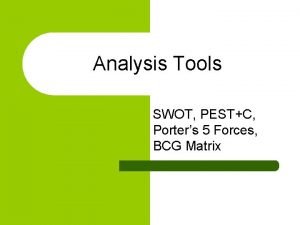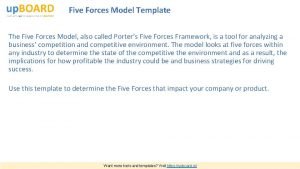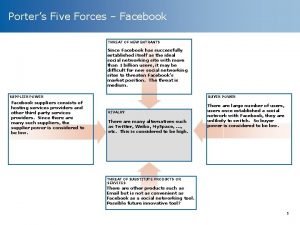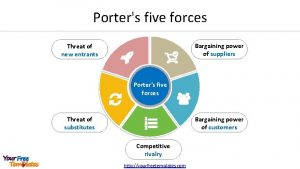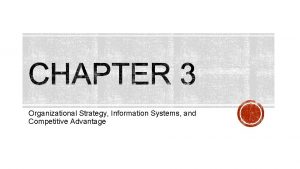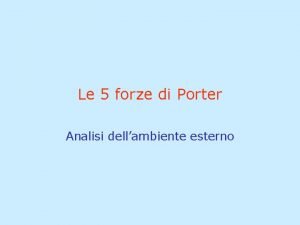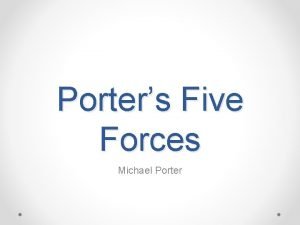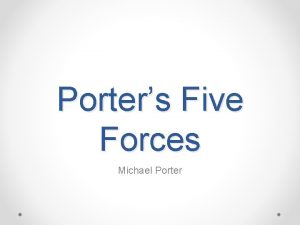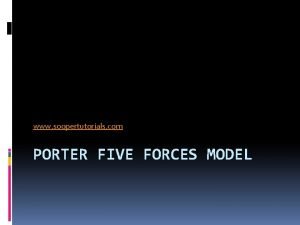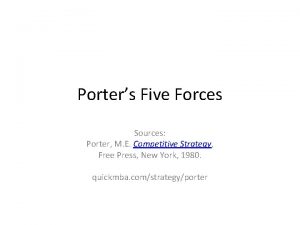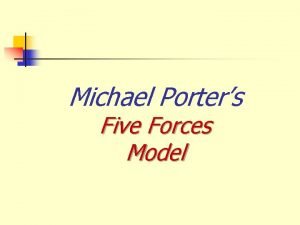The Five Competitive Forces M E Porter The










- Slides: 10

The Five Competitive Forces… M. E. Porter The Concept The extended rivalry that results from all five forces defines an industry’s structure It also shapes the nature of competitive interaction within an industry The underlying drivers of profitability in any particular industry are the same If the forces are intense, almost no company earns attractive returns on investment If the forces are benign, many companies are profitable. Many factors (in addition to the 5 forces) affect profitability in the short run Industry structure, manifested in the competitive forces, sets industry profitability in the medium and long run Defending against competitive forces and shaping them in a company’s favor are crucial By considering all five forces, a strategist keeps overall structure in mind instead of gravitating to any one element – a must for a successful analysis & strategy The five competitive forces provide a framework for: identifying the most important developments and anticipating their impact on industry attractiveness Every company should already know what the average profitability of its industry is and how it has been changing over time To capture more profits from rivals, the starting point is to determine which force or forces are currently constraining industry profitability and address them The goal is to reduce the share of profits that leak to suppliers, buyers & substitutes or are sacrificed to deter new entrants

The Five Competitive Forces… M. E. Porter (Cont’d) Typical Steps in Industry Analysis 1. Define the Relevant Industry What products are in it? Which ones are part of another distinct Industry? What is the geographic scope of competition? Drawing industry boundaries correctly, around the arena in which competition actually place, will clarify the causes of profitability and the appropriate unit for setting strategy If industry structure for two products is the same or similar, those products are best treated as being part of the same industry If an industry has quite different structures in different geographic regions, each region may be a distinct industry A rule of thumb: Where the differences in any one force are large, and Where the differences involve more than one force, …. . distinct industries may be present

The Five Competitive Forces… M. E. Porter (Cont’d. ) Typical Steps in Industry Analysis Cont’d. 2. Identify the participants and segment them into teams Who are the buyers or buyer groups? Who are the supplier or supplier groups? Who are the competitors? What substitutes exist? Who are the potential entrants?

The Five Competitive Forces… M. E. Porter (Cont’d. ) Typical Steps in Industry Analysis Cont’d. 3. Assess the underlying drivers of each competitive force in order to determine which forces are strong and which are weak and why Threat of New Entrants Bargaining Power of Suppliers Rivalry Among Existing Competitors Threat of Substitutes Bargaining Power of Buyers

The Five Competitive Forces… M. E. Porter (Cont’d. ) Typical Steps in Industry Analysis Cont’d. 3. Assess the five forces Cont’d. For the most part the analysis here takes the perspective of a company already present in the industry THREAT OF ENTRY New entrants to an industry bring: new capacity and a desire to gain market share This puts pressure on: prices costs and the rate of investments necessary to compete When the threat is high, incumbents must: hold down their prices or boost investment to deter new competitors The following are major barriers that incumbents have over new entrants: a) Economies that arise when firms produce at larger volumes b) Buyers may trust larger companies for a crucial product c) If switching costs (fixed costs faced by buyers when changing suppliers) are high, it is difficult for new players to gain customers

The Five Competitive Forces… M. E. Porter (Cont’d. ) Typical Steps in Industry Analysis Cont’d. 3. Assess the five forces Cont’d. THREAT OF ENTRY cont’d. d) The need to invest large financial resources in order to compete can deter new entrants e) Incumbents may have cost or quality advantages not available to new rivals f) New entrants must secure distribution of its product or service – may be difficult to find g) Government policy can hinder or aid new entry directly as well as amplify other entry barriers h) How potential entrants believe incumbents may react will also influence their decision to enter or stay out of an industry POWER OF SUPPLIERS Powerful suppliers (Including suppliers of labor) can squeeze profitability out of an industry that is unable to pass on cost increases in its own prices A supplier group is powerful if: it is more concentrated than the industry it sells to it does not depend heavily on a particular industry for its revenues industry participants face switching costs in changing suppliers offer products that are differentiated there is no substitute for what the supplier group provides the supplier group can credibly threaten to integrate forward into the industry

The Five Competitive Forces… M. E. Porter (Cont’d. ) Typical Steps in Industry Analysis Cont’d. 3. Assess the five forces Cont’d. POWER OF BUYERS Powerful customers can capture more value by: forcing down prices demanding better quality demanding more service or playing industry participants against one another A customer group has negotiating leverage if: there are few buyers each buyer purchases in volumes that are large relative to the size of a single vendor the suppliers group has high fixed costs the industry’s products are standardized or undifferentiated buyers face few switching costs in changing vendors buyers can credibly threaten to integrate backward and produce the industry’s products THE THREAT OF SUBSTITUTES A substitute performs the same or a similar function as an industry’s product by different means Substitute products or services limit an industry’s profit potential by placing a ceiling on prices

The Five Competitive Forces… M. E. Porter (Cont’d. ) Typical Steps in Industry Analysis Cont’d. 3. Assess the five forces Cont’d. RIVALRY AMONG EXISTING COMPETITORS Takes many forms: price discounting new product introductions advertising campaigns service improvements Rivalry is especially destructive to profitability if it gravitates solely to price The intensity of rivalry is greatest if: competitors are numerous competitors are roughly equal in size and power industry growth is slow exit barriers are high rivals are highly committed to the business and have aspirations of leadership

The Five Competitive Forces… M. E. Porter (Cont’d. ) Typical Steps in Industry Analysis Cont’d. 4. Determine overall industry structure, and test the analysis for consistency Why is the level of profitability what it is? Which are the controlling forces of profitability? Is the industry analysis consistent with actual long-run profitability? One of the essential tasks in industry analysis is to distinguish temporary or cyclical changes from structural changes A good guideline for the appropriate time horizon is the full business cycle for the particular industry (usually but not always 3 to 5 years) Are more-profitable players better positioned in relation to the five forces? 5. Analyze recent and likely future changes in each force (both positive and negative) 6. Identify aspects of industry structure that might be influenced by: competitors new entrants or your company

The Five Competitive Forces… M. E. Porter (Cont’d. ) Common Pitfalls In conducting the industry analysis avoid the following common mistakes Defining the industry too broadly or too narrowly Making lists instead of engaging in rigorous analysis Treating all forces equally rather than digging deeply into the most important ones Confusing effect (price sensitivity) with cause (buyer economics) Using static analysis that ignores industry trends Confusing cyclical or transient changes with true structural changes Using the framework to declare an industry attractive or unattractive rather than using it to guide strategic choices
 Pestc
Pestc Five forces model template
Five forces model template Porter's five forces facebook
Porter's five forces facebook Porter's five forces
Porter's five forces Costa coffee porter's five forces
Costa coffee porter's five forces Porters generic strategy
Porters generic strategy How does organizational strategy determine is requirements
How does organizational strategy determine is requirements Forze di porter
Forze di porter Competitive and non competitive antagonist
Competitive and non competitive antagonist Market commonality and resource similarity examples
Market commonality and resource similarity examples What is the least competitive market structure
What is the least competitive market structure
